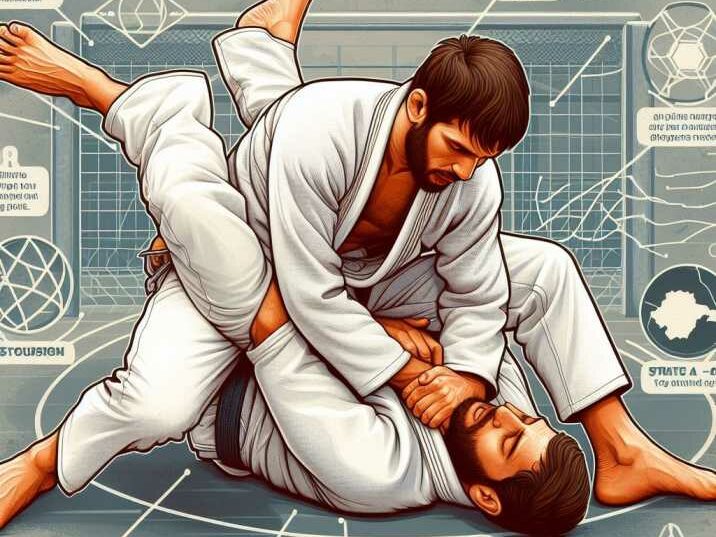Introduction
Table of Contents
Mixed Martial Arts (MMA) is a full-contact combat sport that combines techniques from various martial arts disciplines. The sport has grown in popularity over the years, with the Ultimate Fighting Championship (UFC) being the largest Mixed Martial Arts promotion company worldwide. But have you ever wondered how many fighting styles in MMA?
The answer is, that there are numerous styles, with fighters often specializing in one or two but training in several others. Here we’ll explore the most common martial arts styles used in Mixed Martial Arts.

Table of Contents
- Introduction
- Fighting Styles in MMA
- Striking Styles
- Grappling Styles
- Other Martial Arts Styles
- The Beauty of Diversity
- Complete Fighter Development
- Strategic Depth
- An Evolving Sport
- Benefits Beyond the Octagon
- Improved Fitness
- Enhanced Self-Defense Skills
- Development of Mental Toughness
- Conclusion
Fighting Styles in MMA
Striking Styles
Striking styles focus on techniques that attack an opponent from a distance using punches, kicks, knee strikes, and elbow strikes. The goal is to knock out or knock down the opponent to gain a dominant position or end the fight. Here are some of the most common striking styles used in Mixed Martial Arts:
Boxing:
Boxing is a traditional martial art that focuses solely on punching techniques. Boxers are known for their hand speed, footwork, and powerful punching combinations. Many Mixed Martial Arts fighters train in boxing to improve their punching technique.
Muay Thai/Kickboxing:
Muay Thai is a stand-up striking art that originated in Thailand. It’s known for its powerful kicks, punches, elbow strikes, and knee attacks. Kickboxing is a hybrid martial art that combines elements of boxing and kicking techniques. Both Muay Thai and kickboxing are highly effective in Mixed Martial Arts due to the variety of strikes they teach.

Karate:
Karate is a Japanese martial art that emphasizes striking with kicks, punches, and open-handed techniques. It also teaches various blocking techniques and strikes with the elbow and knee. While karate is not as popular in Mixed Martial Arts as some other styles, some fighters still use its techniques effectively.
Taekwondo:
Taekwondo is a Korean martial art that emphasizes kicking techniques. It’s known for its high-flying kicks, speed, and agility. While taekwondo is an Olympic sport, its techniques are less common in MMA due to the sport’s emphasis on kicking and limited training in punching and grappling compared to other martial arts.
Grappling Styles
Grappling styles focus on clinching with an opponent and taking the fight to the ground to use submission holds or achieve a dominant position. Here are some of the most common grappling styles used in MMA:
Brazilian Jiu-Jitsu (BJJ):
BJJ is a grappling-based martial art that focuses on ground fighting, submission holds, joint locks, and chokes. BJJ practitioners, known as “BJJers,” are known for their ability to defeat larger opponents using leverage and technique. BJJ is one of the most common styles in MMA due to its effectiveness on the ground.
Wrestling: Wrestling is a grappling-based martial art that focuses on takedowns, throws, and controlling positions on the ground. There are several styles of wrestling, including folkstyle, freestyle, and Greco-Roman. Wrestlers are known for their strength, explosiveness, and endurance. Many successful Mixed Martial Arts fighters have a wrestling background due to their effectiveness in controlling positions and neutralizing opponents.
Judo:
Judo is a grappling-based martial art that focuses on throws, takedowns, and submission holds. It’s known for its explosive techniques that aim to quickly end a fight. While judo is an Olympic sport, its techniques are less common in Mixed Martial Arts compared to wrestling and BJJ due to the sport’s emphasis on standing grappling and limited training in ground fighting.
Sambo:
Sambo is a grappling-based martial art that originated in the Soviet Union. It’s a hybrid style that combines elements of judo, wrestling, and boxing. Sambo focuses on takedowns, submission holds, and ground-and-pound striking. While sambo is not as well-known as some other grappling styles, it’s highly effective in MMA due to its well-rounded skill set.
Other Martial Arts Styles
While the above styles are the most common in MMA, fighters may also train in other martial arts to improve their skills. Here are a few examples:
Kung Fu:
Kung fu is a term that encompasses a variety of Chinese martial arts. Some kung fu styles focus on striking, while others focus on grappling or a combination of both. While kung fu is not as common in MMA as some other styles, some fighters use its techniques effectively.
Catch Wrestling:
Catch wrestling is a grappling-based martial art that focuses on submission holds, joint locks, and ground-and-pound striking. It’s known for its aggressive and controlling style. While catch wrestling is not as well-known as BJJ or wrestling, it’s highly effective in MMA due to its focus on finishing fights with submissions.
Sanda/Sanshou/Wushu:
Sanda, also known as sanshou or wushu, is a Chinese martial art that combines elements of traditional kung fu with modern combat techniques. It’s known for its high-flying kicks, punches, and grappling techniques. While sanda is not as common in MMA as some other styles, some fighters use its techniques effectively.
The Beauty of Diversity:
The inclusion of multiple fighting styles infuses MMA with an unparalleled level of excitement and unpredictability. This diversity not only showcases the vast array of martial arts but also highlights the adaptability and creativity of MMA fighters.
Complete Fighter Development:
At the heart of MMA lies the concept of creating well-rounded athletes. Fighters undergo rigorous training in striking, grappling, and takedown defense, ensuring they possess the versatility to excel in all aspects of combat. This comprehensive approach allows fighters to seamlessly transition between different techniques and exploit their opponent’s weaknesses.
Strategic Depth:
The fusion of various martial arts styles adds a layer of complexity to MMA bouts, necessitating strategic depth and meticulous planning. Fighters must analyze their strengths and weaknesses, along with those of their opponents, to devise effective game plans. This strategic chess match elevates MMA to more than just a physical contest but a battle of wits and tactics.
An Evolving Sport:
MMA is not stagnant; it is a constantly evolving sport. Fighters continuously experiment with new techniques and strategies, pushing the boundaries of what is possible in combat sports. This relentless pursuit of innovation ensures that MMA remains at the forefront of athletic competition, captivating audiences with its ever-changing landscape.
Benefits Beyond the Octagon:
Beyond the realm of competition, training in MMA offers a plethora of benefits that extend into everyday life.
Improved Fitness:
MMA workouts are renowned for their intensity and effectiveness in building overall fitness. Combining cardio, strength training, and flexibility exercises, MMA training results in a well-conditioned physique capable of enduring the rigors of combat.
Enhanced Self-Defense Skills:
Learning various fighting techniques empowers individuals with the knowledge and confidence to defend themselves in real-world situations. The practicality of MMA techniques makes it an invaluable tool for personal protection.
Development of Mental Toughness:
MMA training instills discipline, mental fortitude, and the ability to perform under pressure. These qualities not only benefit fighters inside the cage but also translate into other aspects of life, fostering resilience and determination.
Conclusion
MMA is a hybrid combat sport that allows fighters to use techniques from various martial arts disciplines. While fighters often specialize in one or two styles, they typically train in several others to improve their overall game. The most common styles used in MMA include boxing, Muay Thai/kickboxing, karate, taekwondo, Brazilian jiu-jitsu, wrestling, judo, and sambo. However, fighters may also train in other martial arts like kung fu, catch wrestling, and sanda to improve their skills and gain an edge over opponents.
Whether you’re an MMA fighter or just starting your martial arts journey, understanding the different styles used in the sport can help you choose the best style or styles to train in. Remember, each style has its strengths and weaknesses, and the most well-rounded fighters are those who are proficient in both striking and grappling.
FAQs (Frequently Asked Questions):
Q: How many fighting styles are commonly used in MMA?
A: MMA fighters often train in a combination of Brazilian Jiu-Jitsu, Muay Thai, wrestling, boxing, and other martial arts, depending on their individual strengths and preferences.
Q: Are there any traditional martial arts that are not commonly seen in MMA?
A: While traditional martial arts like Aikido and Tai Chi have their merits, they are less prevalent in MMA due to their focus on techniques that may not be practical in a competitive setting.
Q: Can anyone learn MMA, regardless of age or experience?
A: MMA training is accessible to individuals of all ages and experience levels, with many gyms offering classes tailored to beginners as well as advanced practitioners.
Q: How long does it take to become proficient in MMA?
A: Becoming proficient in MMA requires consistent training and dedication, with most fighters spending several years honing their skills before competing at a professional level.
Q: Is MMA a safe sport to participate in?
A: While MMA carries inherent risks like any combat sport, proper training, supervision, and adherence to rules and regulations help minimize the risk of injury for participants.


